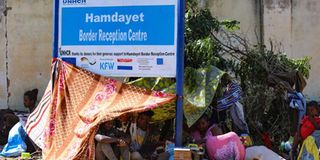Kenya’s new refugee law reinforces regional ‘Marshall Plan’ for the displaced in the Horn

Ethiopians, who fled their homes due to ongoing fighting, are pictured at a refugee camp in the Hamdait border area of Sudan's eastern Kassala state on November 12, 2020.
Everybody is a potential refugee. This dictum is even truer in our increasingly uncertain and war-prone multi-polar world. Perhaps none of the more than five million people who have fled Ukraine since Russia’s invasion began on February 24 were ever prepared for their new life as refugees in the neighbouring countries.
Closer home, the estimated 59,000 Ethiopians now living in eastern Sudan never envisaged that the out-break of the armed conflict between the Ethiopian government and the Tigray People’s Liberation Front (TPLF) on November 4, 2020, could turn them into refugees.
Once driven away, refugees cannot return to their homes because of escalating conflict and insecurity. This has created protracted refugee situations. Worse still, a new wave of populism and xenophobia has restricted access to asylum in wealthy countries of Europe and North America. Countries in the Horn and their partners adopted a humanitarian version of the ‘Marshall Plan’—the European Recovery Program estimated at $115 billion that the US mooted to support the recovery of Western European economies after World War II.
The emerging refugee model drew on lessons from progressive local country-based success stories, particularly refugee settlements in Uganda and Kenya’s Kalobeyei integrated settlement. It also reflected the goals of both the African Union’s Agenda 2063 and the UN Sustainable Development Goals (SDGs) to minimise risks that generate refugees. The rise of the model was hastened by the appointment of the Special Envoy of UNHCR for the Somalia refugee situation in 2016, later expanded to Special Envoy for the Horn of Africa.
Somali Refugees
In March 2017, a special summit of the leaders of the Inter-Governmental Agency on Development (IGAD) member states adopted the Declaration on Durable Solutions for Somali Refugees and Reintegration of Returnees in Somalia and its Action Plan, Nairobi formed the lynchpin of a new framework of cooperation and solidarity towards refugees.
A new report by this author, Refugees and Citizenship, Lessons from IGAD’s Regional Response Framework 2017-2021 launched on Thursday, takes stock of the key lessons in the implementation of this regional ‘Marshall Plan’.
IGAD’s ‘Marshall Plan’ is embedded in five pillars. First is the imperative to create conditions for safe and dignified return of the displaced to the countries or communities of origin. This include prioritising the root causes of forced displacement, as well as the recovery and reconstruction, mainly of Somalia and South Sudan.
Second is the expansion of asylum and protection space. Under the new regime, displaced persons have legal identity documentation, including a birth certificate and a nationality documentation registered and certified by competent authorities. These are preconditions to exercise their fundamental rights.
Since 2019, refugees in Kenya have been included in the national census and development planning. Many countries in the region have moved from camps to settlements.
Third is the need to expand asylum and protection space to enable refugees to access the same services and opportunities as citizens and to ensure self-reliance of the displaced and host communities. Under the new regime, refugees can access education, jobs and livelihoods. Self-reliance and access to services seek to help them escape from dependency on declining humanitarian aid, restore their dignity, minimise tensions with host communities and safeguard the environment.
It is in response to this crisis that in November 2021, President Uhuru Kenyatta signed a new law that allows nearly half a million refugees living in Kenya an opportunity to integrate into the economy, have better access to education, work and lead a decent life. To be sure, Kenya’s new refugee law reflects a new regional ‘Marshall Plan’ adopted by the Horn of African countries four years ago.
Partnerships
Fourth is the need to strengthen regional capacity, particularly within the IGAD Secretariat, for cooperation, coordination and monitoring the implementation of policies and programmes. Finally, is the forging of multi-stakeholder partnerships of governments, local non-state actors, humanitarian and development actors for refugees within the context of international solidarity and responsibility sharing to ease pressure on refugee-hosting countries and communities. In the Horn, as elsewhere, the concept of responsibility sharing has been expanded to include both local and global partnerships of humanitarian and development actors to broaden the collective effort in pursuit of durable solutions.
However, the outbreak of Covid-19 greatly slowed down the implementation of the Nairobi process and the GCR model. The pandemic diminished humanitarian aid, created unemployment and lack of resources that slowed down the implementation of the IGAD model of response to the displaced. In its wake, the Nairobi process has evolved into one of the most comprehensive applications of the New York Declaration for Refugees and Migrants by any region. It greatly influenced the agenda of the Global Refugee Forum populism (GRF), the first of its kind, held in December 2019.
When fully implemented, the IGAD model can gradually transform the displaced into “community citizens”. In this regard, the report highlights the inextricable link between refugees and citizenship. In exile, refugees lose their citizenship. It posits that the Economic Community of West African States and the EAC have embraced the concept of ‘regional citizenship’, which enables refugees to regain rights.
The lessons of IGAD’s Nairobi process have inspired the ‘Solutions Initiative for the Displacement Situation in Sudan and South Sudan’, an initiative by IGAD and UNHCR to enable the two countries to find lasting solutions to the displacement crisis facing them.
The emerging IGAD refugee response architecture carries important lessons that can inform responses to other complex displacement situations in the Horn and beyond.
Prof. Peter Kagwanja is president & chief executive at the Africa Policy Institute. He is also a consultant with UNHCR.





